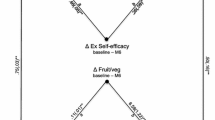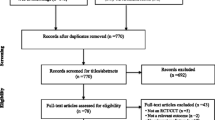Abstract
Background
Behavioral obesity treatments have generally been unsuccessful at facilitating long-term weight reductions. Increased physical activity/exercise is a strong predictor of maintained weight loss. It has been proposed this is more linked to increases in exercise-related self-regulation carrying-over to eating-related self-regulation than through direct energy expenditures.
Methods
Women with obesity participated in 10-month community-based behavioral treatments that had theory-based foci on either self-regulation skills building (n = 59) or knowledge of weight loss methods (n = 54). Physical activity/exercise, exercise-related self-regulation, and eating-related self-regulation were assessed at baseline and months 3, 6, and 12 in the prediction of weight and waist circumference changes over 24 months.
Results
Significant overall improvements on all measures were found, which were significantly greater in the self-regulation-focused group than the knowledge-focused group. Mean reductions in waist circumference/weight were − 4.64 cm/ − 5.17 kg (− 5.5% of baseline weight) and − 0.66 cm/ − 1.19 kg (− 1.2% of baseline weight), respectively. Aggregated data indicated that early increase in physical activity/exercise significantly predicted 24-month reductions in both weight and waist circumference. Serial mediation analyses indicated that a sequential path from exercise-related self-regulation (baseline–month 3) → eating-related self-regulation (baseline–month 6) → eating-related self-regulation (baseline–month 12) fully mediated the physical activity/exercise-weight/waist circumference change relationships. Energy expenditures from physical activity/exercise accounted for 21% of lost weight.
Conclusions
Findings of this field research supported benefits of progressively building self-regulation skills, first for physical activity/exercise then controlled eating, through accordingly focused behavioral treatments. Opportunities for tailoring large-scale community-based interventions grounded in theory were enhanced.


Similar content being viewed by others
References
Hales CM, Carroll MD, Fryar CD, Ogden CL. Prevalence of obesity and severe obesity among adults: United States, 2017–2018. NCHS data brief, no 360. Hyattsville, MD: National Center for Health Statistics. 2020.
Bish CL, Blanck HM, Serdula MK, et al. Diet and physical activity behaviors among Americans trying to lose weight: 2000 Behavioral Risk Factor Surveillance System. Obes Res. 2005;13(3):596–607. https://doi.org/10.1038/oby.2005.64.
Stokes A, Collins JM, Grant BF, et al. Prevalence and determinants of engagement with obesity care in the United States. Obesity. 2018;26(5):814–8. https://doi.org/10.1002/oby.22173.
Dombrowski SU, Knittle K, Avenell A, Araújo-Soares V, Sniehotta FF. Long term maintenance of weight loss with non-surgical interventions in obese adults: systematic review and meta-analyses of randomised controlled trials. BMJ. 2014;348: g2646. https://doi.org/10.1136/bmj.g2646.
Loveman E, Frampton GK, Shepherd J, et al. The clinical effectiveness and cost-effectiveness of long-term weight management schemes for adults: a systematic review. Health Technol Assess. 2011;15(2):1–182. https://doi.org/10.3310/hta15020.
Mann T, Tomiyama AJ, Westling E, et al. Medicare’s search for effective obesity treatments: diets are not the answer. Am Psychol. 2007;62(3):220–33. https://doi.org/10.1037/0003-066X.62.3.220.
MacLean PS, Wing RR, Davidson T, et al. NIH working group report: innovative research to improve maintenance of weight loss. Obesity. 2015;23(1):7–15. https://doi.org/10.1002/oby.20967.
Champion VL, Skinner CS. The health belief model. In: Glanz K, Rimer BK, Viswanath K, editors. Health behavior and health education. 4th ed. San Francisco, CA: Jossey-Bass; 2008. p. 45–65.
Bandura A. Social foundations of thought and action: a social cognitive theory. Englewood Cliffs, NJ: Prentice Hall; 1986.
Teixeira PJ, Carraça EV, Marques MM, et al. Successful behavior change in obesity interventions in adults: a systematic review of self-regulation mediators. BMC Med. 2015;13:84. https://doi.org/10.1186/s12916-015-0323-6.
Bandura A. The primacy of self-regulation in health promotion. Appl Psychol. 2005;54(2):245–54. https://doi.org/10.1111/j.1464-0597.2005.00208.x
Harrison JA, Mullen PD, Green LW. A meta-analysis of studies of the health belief model with adults. Health Educ Res. 1992;7(1):107–16. https://doi.org/10.1093/her/7.1.107.
Whitehead D. A social cognitive model for health education/health promotion practice. J Adv Nurs. 2001;36(3):417–25. https://doi.org/10.1046/j.1365-2648.2001.01973.x.
Campbell C. Health psychology and community action. In: Murray M, editor. Critical Health Psychology. London, UK: Palgrave; 2004. p. 203–21.
Cooper Z, Doll HA, Hawker DM, et al. Testing a new cognitive behavioural treatment for obesity: a randomized controlled trial with three-year follow-up. Behav Res Ther. 2010;48(8):706–13. https://doi.org/10.1016/j.brat.2010.03.008.
Svetkey LP, Stevens VJ, Brantley PJ, et al. Comparison of strategies for sustaining weight loss: the weight loss maintenance randomized controlled trial. JAMA. 2008;299(10):1139–48. https://doi.org/10.1001/jama.299.10.1139.
Cooper Z, Fairburn CG, Hawker DM. Cognitive-behavioral treatment of obesity: a clinician’s guide. New York, NY: Guilford; 2003.
Annesi JJ. Sequential changes advancing from exercise-induced psychological improvements to controlled eating and sustained weight loss: a treatment-focused causal chain model. Perm J. 2020;24:19.235. https://doi.org/10.7812/TPP/19.235.
Jeffery RW, Drewnowski A, Epstein LH, et al. Long-term maintenance of weight loss: current status. Health Psychol. 2000;19(suppl 1):5–16. https://doi.org/10.1037/0278-6133.19.suppl1.5.
Donnelly JE, Blair SN, Jakicic JM, et al. American College of Sports Medicine position stand. Appropriate physical activity intervention strategies for weight loss and prevention of weight regain for adults. Med Sci Sports Exerc. 2009;41(2):459–71. https://doi.org/10.1249/MSS.0b013e3181949333
Troiano RP, Berrigan D, Dodd KW, et al. Physical activity in the United States measured by accelerometer. Med Sci Sports Exerc. 2008;40(1):181–8. https://doi.org/10.1249/mss.0b013e31815a51b3.
Piercy KL, Troiano RP, Ballard RM, et al. The physical activity guidelines for Americans. JAMA. 2018;320(19):2020–8. https://doi.org/10.1001/jama.2018.14854.
Mata J, Silva MN, Vieira PN, et al. Motivational “spill-over” during weight control: increased self-determination and exercise intrinsic motivation predict eating self-regulation. Health Psychol. 2009;28(6):709–16. https://doi.org/10.1037/a0016764.
Baker CW, Brownell KD. Physical activity and maintenance of weight loss: physiological and psychological mechanisms. In: Bouchard C, editor. Physical activity and obesity. Champaign, IL: Human Kinetics; 2000. p. 311–28.
Vohs KD, Baumeister RF, editors. Handbook of self-regulation: research, theory, and applicationNew York. 3rd ed. NY: Guilford; 2016.
Hagger MS, Wood C, Stiff C, Chatzisarantis NL. Ego depletion and the strength model of self-control: a meta-analysis. Psychol Bull. 2010;136(4):495–525. https://doi.org/10.1037/a0019486.
Ross R, Neeland IJ, Yamashita S, et al. Waist circumference as a vital sign in clinical practice: a consensus statement from the IAS and ICCR Working Group on Visceral Obesity. Nat Rev Endocrinol. 2020;16(3):177–89. https://doi.org/10.1038/s41574-019-0310-7.
Azevedo MR, Araújo CL, Reichert FF, et al. Gender differences in leisure-time physical activity. Int J Public Health. 2007;52(1):8–15. https://doi.org/10.1007/s00038-006-5062-1.
Tamres LK, Janicki D, Helgeson VS. Sex differences in coping behavior: a meta-analytic review and an examination of relative coping. Pers Soc Psychol Rev. 2002;6(1):2–30. https://doi.org/10.1207/S15327957PSPR0601_1.
Kosteli M-C, Cumming J, Williams SE. Self-regulatory imagery and physical activity in middle-aged and older adults: a social-cognitive perspective. J Aging Phys Act. 2018;26(1):14–24. https://doi.org/10.1123/japa.2016-0024.
Wardle J, Haase AM, Steptoe A, et al. Gender differences in food choice: the contribution of health beliefs and dieting. Ann Behav Med. 2004;27(2):107–16. https://doi.org/10.1207/s15324796abm2702_5.
Godin G. The Godin-Shephard Leisure-Time Physical Activity Questionnaire. Health Fitness J Canada. 2011;4(1):18–22. https://doi.org/10.14288/hfjc.v4i1.82
Jetté M, Sidney K, Blümchen G. Metabolic equivalents (METS) in exercise testing, exercise prescription, and evaluation of functional capacity. Clin Cardiol. 1990;13(8):555–65. https://doi.org/10.1002/clc.4960130809.
Pereira MA, FitzerGerald SJ, Gregg EW, et al. A collection of physical activity questionnaires for health-related research. Med Sci Sports Exerc. 1997;29(suppl 6):S1–205.
Annesi JJ, Marti CN. Path analysis of exercise treatment-induced changes in psychological factors leading to weight loss. Psychol Health. 2011;26(8):1081–98. https://doi.org/10.1080/08870446.2010.534167.
White IR, Horton NJ, Carpenter J, Pocock SJ. Strategy for intention to treat analysis in randomised trials with missing outcome data. BMJ. 2011;342: d40. https://doi.org/10.1136/bmj.d40.
Little RJ, Rubin DB. Statistical Analysis with Missing Data. 2nd ed. Hoboken, NJ: Wiley; 2014.
Cromwell JB, Hannan MJ, Labys WC, Terraza M. Multivariate tests for time series models. Newbury Park, CA: Sage; 1994.
Ding W, Song PX-K. EM algorithm in Gaussian copula with missing data. Comput Stat Data Anal. 2016;101:1–11. https://doi.org/10.1016/j.csda.2016.01.008.
Cohen J. A power primer. Psychol Bull. 1992;112(1):155–9. https://doi.org/10.1037//0033-2909.112.1.155.
Kim Y, Steiner PM. Gain scores revisited: a graphical models perspective. Sociol Methods Res. 2021;50(3):1353–75. https://doi.org/10.1177/0049124119826155.
Hayes AF. Introduction to mediation, moderation, and conditional process analysis: a regression-based approach. 2nd ed. New York, NY: Guilford. 2018.
Annesi JJ, Gorjala S. Changes in theory-based psychological factors predict weight loss in women with class III obesity initiating supported exercise. J Obes. 2010;2010:171957.
Annesi JJ. Behaviorally supported exercise predicts weight loss in obese adults through improvements in mood, self-efficacy, and self-regulation, rather than by caloric expenditure. Perm J. 2011;15(1):23–7. https://doi.org/10.7812/tpp/10-153.
American College of Sports Medicine. ACSM’s guidelines for exercise testing and prescription. 11th ed. New York, NY: Wolters Kluwer; 2020.
Hall KD. What is the required energy deficit per unit weight loss? Int J Obes. 2008;32(3):573–6. https://doi.org/10.1038/sj.ijo.0803720.
Johnson SS, Paiva AL, Mauriello L, et al. Coaction in multiple behavior change interventions: consistency across multiple studies on weight management and obesity prevention. Health Psychol. 2014;33(5):475–80. https://doi.org/10.1037/a0034215.
Oaten M, Cheng K. Longitudinal gains in self-regulation from regular physical exercise. Br J Health Psychol. 2006;11(pt 4):717–33. https://doi.org/10.1348/135910706X96481.
Telford RD. Low physical activity and obesity: causes of chronic disease or simply predictors? Med Sci Sports Exerc. 2007;39(8):1233–40. https://doi.org/10.1249/mss.0b013e31806215b7.
Jastreboff AM, Kotz CM, Kahan S, Kelly AS, Heymsfield SB. Obesity as a disease: the Obesity Society 2018 position statement. Obesity. 2019;27(1):7–9. https://doi.org/10.1002/oby.22378.
Trost SG, Owen N, Bauman AE, Sallis JF, Brown W. Correlates of adults’ participation in physical activity: review and update. Med Sci Sports Exerc. 2002;34(12):1996–2001. https://doi.org/10.1097/00005768-200212000-00020.
Green LW, Sim L, Breiner H, editors. Evaluating obesity prevention efforts: a plan for measuring progress. Washington, DC: Institute of Medicine of the National Academies; 2013.
Glasgow RE, Emmons KM. How can we increase translation of research into practice? Types of evidence needed. Annu Rev Public Health. 2007;28:413–33. https://doi.org/10.1146/annurev.publhealth.28.021406.144145.
Rosenthal R, Rosnow RL. Artifacts in behavioral research. New York, NY: Oxford University Press; 2009.
Josse AR, Atkinson SA, Tarnopolsky MA, Phillips SM. Increased consumption of dairy foods and protein during diet- and exercise-induced weight loss promotes fat mass loss and lean mass gain in overweight and obese premenopausal women. J Nutr. 2011;141(9):1626–34. https://doi.org/10.3945/jn.111.141028.
Westcott W, Colligan A, Lannutti K, La Rosa Loud R, Vallier S. Effects of resistance exercise and protein on body composition following weight loss. J Clin Exerc Physiol. 2018;7(2):25–32. https://doi.org/10.31189/2165-6193-7.2.25
Acknowledgements
The participants are acknowledged for their contribution to the present research.
Author information
Authors and Affiliations
Contributions
JJA was the sole author and responsible for all aspects of the present research and reporting.
Corresponding author
Ethics declarations
Ethical Approval
All procedures performed in studies involving human participants were in accordance with the ethical standards of the institutional and/or national research committee and with the 1964 Helsinki declaration and its later amendments or comparable ethical standards.
Informed Consent
Informed consent was obtained from all individual participants included in the study.
Competing Interests
The authors declare no competing interests.
Additional information
Publisher's Note
Springer Nature remains neutral with regard to jurisdictional claims in published maps and institutional affiliations.
Rights and permissions
About this article
Cite this article
Annesi, J.J. Effects of Increased Physical Activity/Exercise on Long-Term Losses in Weight and Waist Circumference: Serial Mediation from Changes in Exercise-Related to Eating-Related Self-Regulation. Int.J. Behav. Med. 30, 334–344 (2023). https://doi.org/10.1007/s12529-022-10106-5
Accepted:
Published:
Issue Date:
DOI: https://doi.org/10.1007/s12529-022-10106-5




